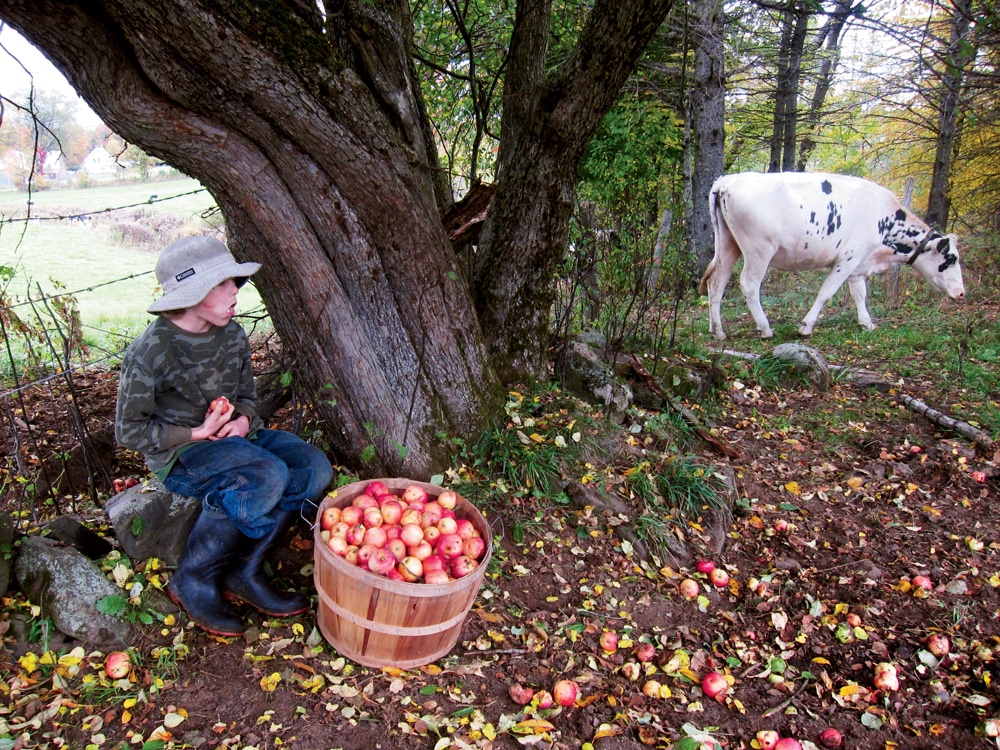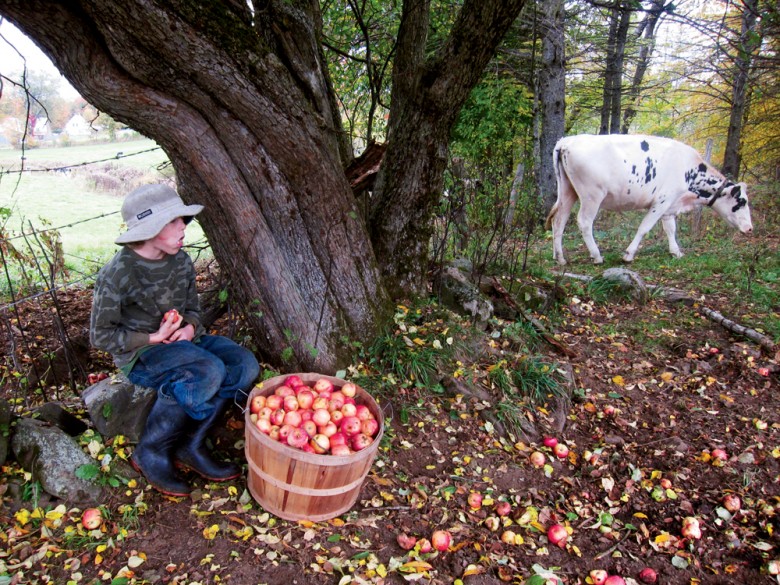A Bittersweet Autumn | Life in the Kingdom
As the Hewitts get ready to leave their homestead of nearly 20 years, small details bring back memories.

The Hewitts’ last fall on their old homestead: As one of the family’s cows grazes nearby, the author’s younger son, Rye, munches
an apple beneath a favorite tree.

Photo Credit : Penny Hewitt
The cows gather beneath the big apple tree down at the far corner of the field. They’d eat themselves sick on drops if I let them, so I run a short line of electric fence to keep them in check. Every morning, I creep the fence forward a bit, granting them access to a few dozen of the softening fruits, because even a cow needs a treat now and then. I snatch a few of the most promising specimens from the drooping branches and stuff them deep in my pockets. They’re small and scabby but sweet. I’ll eat some of them on my walk back to the house as I follow our two cows, Apple and Pip, to the barn for morning milking. The rest I’ll save for my drive to the job site.
The apples are amazing this year, which is supposed to mean that we’ll have a hard winter, but may just mean that the apples are amazing this year. Part of me wishes for the former; another, slightly larger, part would be fine if it were merely the latter. We’ve had two hard winters in a row now, and, given the complications of our impending move, a minor winter isn’t an unwelcome notion. Though we have to be out of our current home by the end of October, there’ll be plenty more to do to make our new home habitable. We’ll need every break we can get just to have a roof over our heads by winter. Even then, it’s going to be tight.
Already the days are notably shorter. I notice this most in the late afternoons, when I return from a day of framing walls to a landscape that’s already fading into dusk. This daily transition—from building our new home to maintaining our current homestead—has proved to be the most challenging aspect of the entire process. Partly, it’s simple fatigue—the bone-weary reality of chores at the end of what has already been a 12-hour workday. But I think it’s also the strange emotional terrain of working two pieces of land: one that I’ve loved and worked for so long but that will soon pass into other hands; the other that I’m just beginning to know and understand. There are so many surprises in store, and some of them won’t be easy. I know this as certainly as I love my children.
—
During the hectic evening hours, between chores at our soon-to-be-former homestead, I sometimes slip away. I hop the fence between our land and our neighbor Melvin’s pasture, jog down into the woods, then beeline for my favorite chanterelle stash. It’s been an amazing year for chanterelles; they keep emerging from the forest floor in clusters, an ever-bearing fruit of the soil. So I tell myself I’m going for the mushrooms. But I also know that I’m going because every time I go I think it might be the last time I’ll walk this well-trod path.
We’ve been on this land nearly 20 years; for nearly two decades, we’ve explored the surrounding fields and forest. In a few weeks we’ll be gone. So I keep returning to my favorite haunts: the little hollow in our woods with the split rock, a yellow birch emerging improbably from the split; the chanterelles, of course; the debris hut that Rye built, the one he and I spent a January night in a couple of winters back. I was nearest to the entrance, and slept fitfully in the cold.
I remember telling a friend about my sadness in leaving this place and, more specifically, in leaving everything that makes this place this place. I told her about how I kept trying to imagine how I’d replace all those things: I’d find a new mushroom stash; I’d build a debris hut with my son and sleep in it; maybe I’d even locate a split rock, tuck a birch sapling into that cleft, will it to take root. “You can’t replace those things,” she said. “And that’s hard. But there will be other things. There will be other experiences that will fill you in similar ways. That’s what life is all about.” A piece of me hoped she was wrong; it felt simpler, safer, more certain, to re-create what I was leaving behind. But I knew she was right.
—
The weather holds, day after day of blue skies and moderate temperatures. It’s more ideal than we could have dared hope, an improbable stretch of good fortune, and we make tremendous progress. Our new house takes shape: walls, rafters, a roof. It’s small—1,000 square feet—and I’m almost surprised by how quickly it comes together. We install windows—a motley collection of used and overstock units that match in neither color nor style but cost us only pennies on the dollar.
We connect the wood-fired cookstove that will heat the house, our food, and, by virtue of an old copper-range boiler, our water. On cool mornings, we fill the firebox with scraps of lumber so that we can warm our hands while we work, and the presence of fire does much to transform the shell of our house into something that feels like a home.
Finally, in mid-October, the weather breaks, and, one afternoon, snow begins to fall in the manner of almost all first-of-season snows: tentatively, softly, unseriously. I drive home on the cusp of evening, down the Main Street of a nearby town so small that the road might as well have been named Only Street. By now, the storm has intensified; the wind has picked up, too, and the snow sweeps and swirls across the pavement in complicated circular patterns. I fear that if I look too hard, I’ll somehow become lost in them, so I fix my gaze just above the roadway, guiding the truck not so much by the road itself, but by the features that delineate its edge: Houses. Trees. Utility poles.
I pass two children standing at the forward edge of a lawn covered in the detritus of rural living: cars on blocks with hoods propped like open mouths; a four-wheeler; something that looks like a canoe cut in half longways, but this must be a trick of the mind and the weather. Through a curtained window, I can see the spectral glow of a television in an otherwise-darkened room. Smoke from a stovepipe.
The children are ecstatic. They’re leaping and flailing their limbs, yelling into the squall. They don’t just hold their faces to the storm; they actually push into it, mouths agape, the cold flakes tickling their tongues, the tender spot at the back of the throat. I wave, but their attention is elsewhere, and in a moment I’ve passed beyond their small orbit, the tires of the Ford cutting dark lines through the skin of snow. I turn the heater on high and roll down the window just enough to let in a bit of the storm.
Ben Hewitt
The Hewitt family runs Lazy Mill Living Arts, a school for practical skills of land and hand. Ben's most recent book is The Nourishing Homestead, published by Chelsea Green.
More by Ben Hewitt

